Critical Response: Analysis of Blog and LinkedIn Profile on Self
VerifiedAdded on 2022/08/18
|6
|1229
|281
Homework Assignment
AI Summary
This assignment presents a critical response to a blog post from PsychCentral and a LinkedIn profile, examining how social media influences self-perception and the construction of online identities. The analysis explores the goals of each platform, the authors' backgrounds, and the key insights presented. The blog discusses the gap between our online and real selves, the rise of 'smiling depression,' and the relevance of Carl Rogers' theory of personality. The LinkedIn profile showcases professional success. The response compares the credibility of the blog versus the LinkedIn profile, favoring the blog for its authenticity. The assignment also discusses social capital, value creation in internet platforms, and the changing dynamics of power in the digital age, referencing relevant literature.
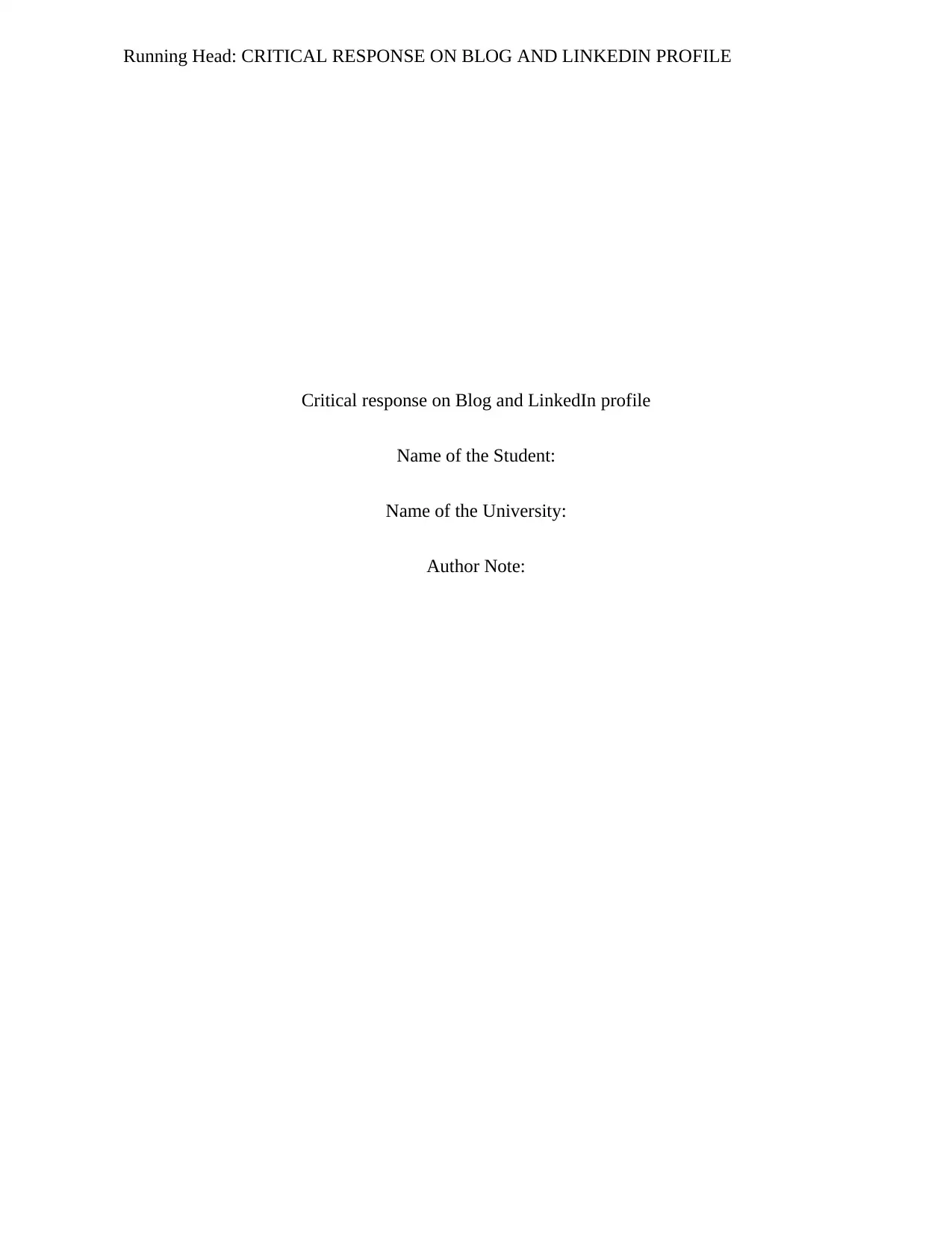
Running Head: CRITICAL RESPONSE ON BLOG AND LINKEDIN PROFILE
Critical response on Blog and LinkedIn profile
Name of the Student:
Name of the University:
Author Note:
Critical response on Blog and LinkedIn profile
Name of the Student:
Name of the University:
Author Note:
Paraphrase This Document
Need a fresh take? Get an instant paraphrase of this document with our AI Paraphraser
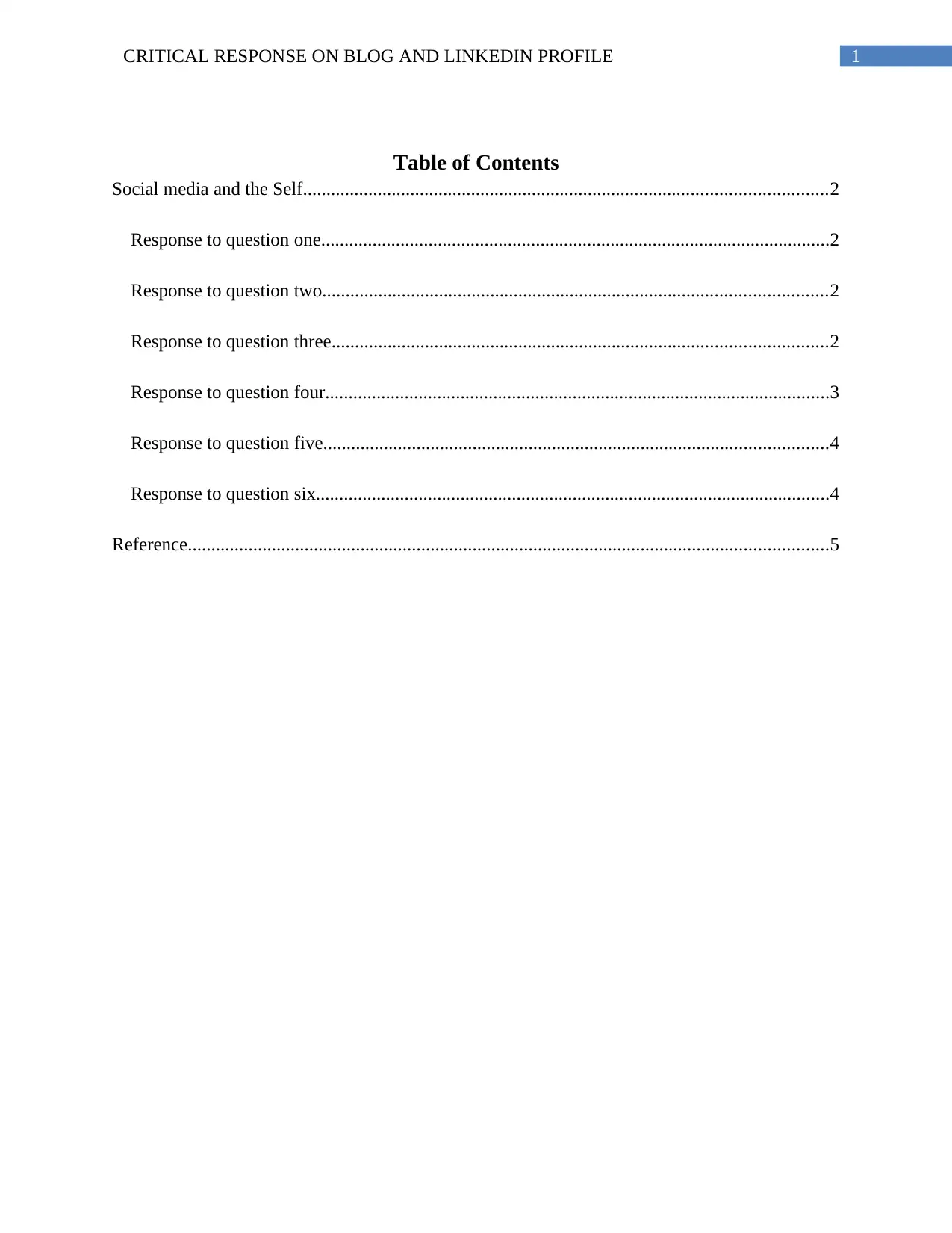
1CRITICAL RESPONSE ON BLOG AND LINKEDIN PROFILE
Table of Contents
Social media and the Self................................................................................................................2
Response to question one.............................................................................................................2
Response to question two............................................................................................................2
Response to question three..........................................................................................................2
Response to question four............................................................................................................3
Response to question five............................................................................................................4
Response to question six..............................................................................................................4
Reference.........................................................................................................................................5
Table of Contents
Social media and the Self................................................................................................................2
Response to question one.............................................................................................................2
Response to question two............................................................................................................2
Response to question three..........................................................................................................2
Response to question four............................................................................................................3
Response to question five............................................................................................................4
Response to question six..............................................................................................................4
Reference.........................................................................................................................................5
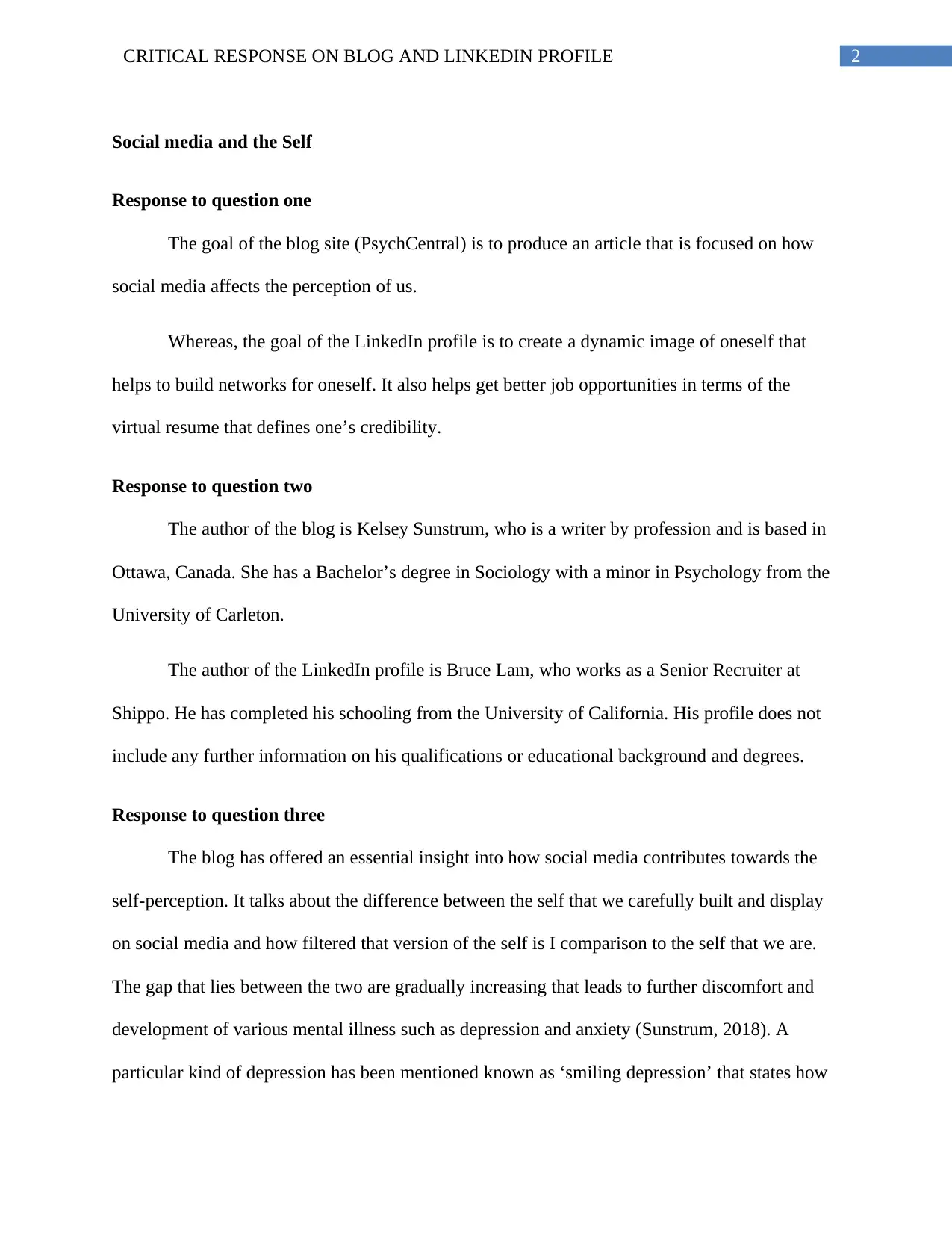
2CRITICAL RESPONSE ON BLOG AND LINKEDIN PROFILE
Social media and the Self
Response to question one
The goal of the blog site (PsychCentral) is to produce an article that is focused on how
social media affects the perception of us.
Whereas, the goal of the LinkedIn profile is to create a dynamic image of oneself that
helps to build networks for oneself. It also helps get better job opportunities in terms of the
virtual resume that defines one’s credibility.
Response to question two
The author of the blog is Kelsey Sunstrum, who is a writer by profession and is based in
Ottawa, Canada. She has a Bachelor’s degree in Sociology with a minor in Psychology from the
University of Carleton.
The author of the LinkedIn profile is Bruce Lam, who works as a Senior Recruiter at
Shippo. He has completed his schooling from the University of California. His profile does not
include any further information on his qualifications or educational background and degrees.
Response to question three
The blog has offered an essential insight into how social media contributes towards the
self-perception. It talks about the difference between the self that we carefully built and display
on social media and how filtered that version of the self is I comparison to the self that we are.
The gap that lies between the two are gradually increasing that leads to further discomfort and
development of various mental illness such as depression and anxiety (Sunstrum, 2018). A
particular kind of depression has been mentioned known as ‘smiling depression’ that states how
Social media and the Self
Response to question one
The goal of the blog site (PsychCentral) is to produce an article that is focused on how
social media affects the perception of us.
Whereas, the goal of the LinkedIn profile is to create a dynamic image of oneself that
helps to build networks for oneself. It also helps get better job opportunities in terms of the
virtual resume that defines one’s credibility.
Response to question two
The author of the blog is Kelsey Sunstrum, who is a writer by profession and is based in
Ottawa, Canada. She has a Bachelor’s degree in Sociology with a minor in Psychology from the
University of Carleton.
The author of the LinkedIn profile is Bruce Lam, who works as a Senior Recruiter at
Shippo. He has completed his schooling from the University of California. His profile does not
include any further information on his qualifications or educational background and degrees.
Response to question three
The blog has offered an essential insight into how social media contributes towards the
self-perception. It talks about the difference between the self that we carefully built and display
on social media and how filtered that version of the self is I comparison to the self that we are.
The gap that lies between the two are gradually increasing that leads to further discomfort and
development of various mental illness such as depression and anxiety (Sunstrum, 2018). A
particular kind of depression has been mentioned known as ‘smiling depression’ that states how
⊘ This is a preview!⊘
Do you want full access?
Subscribe today to unlock all pages.

Trusted by 1+ million students worldwide
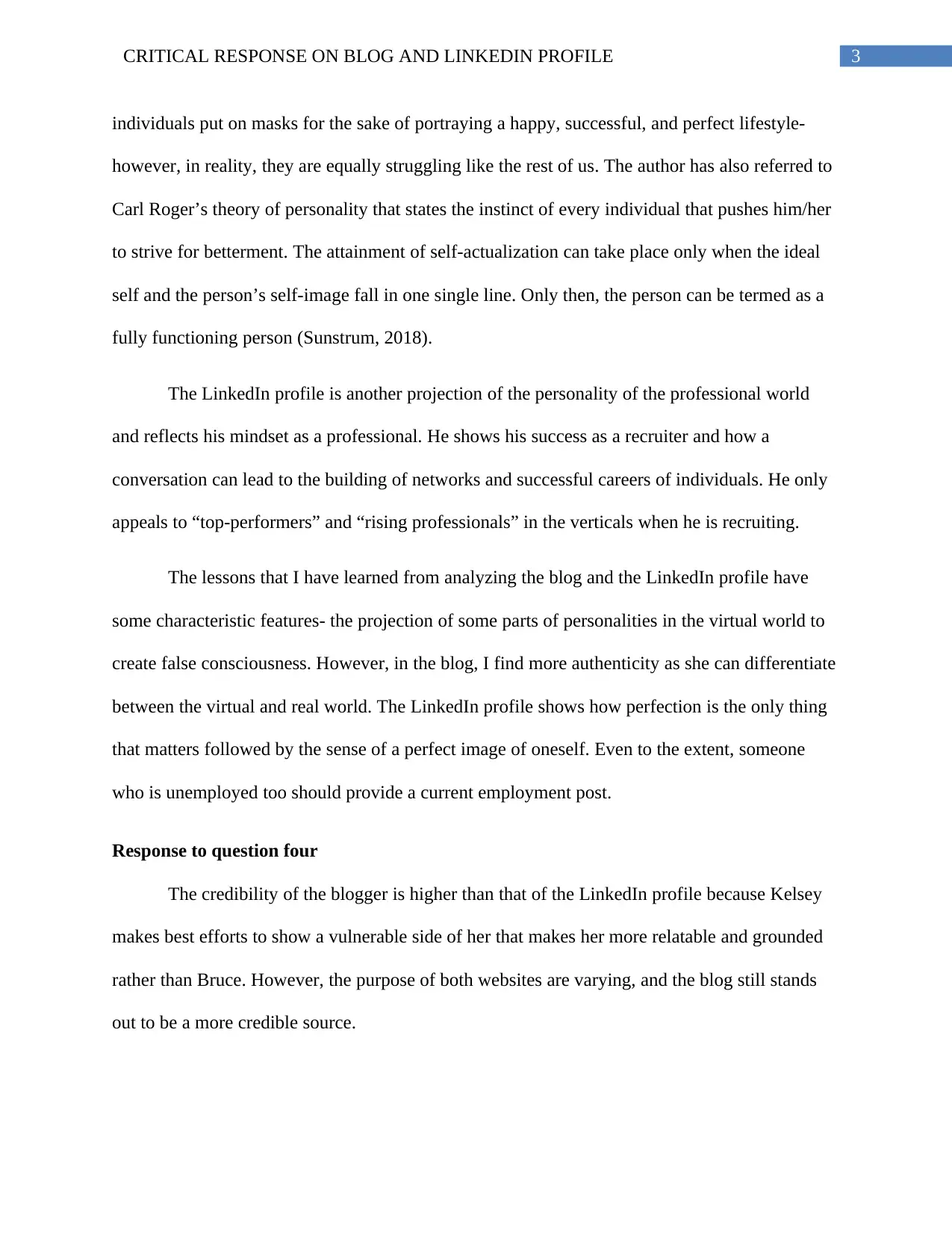
3CRITICAL RESPONSE ON BLOG AND LINKEDIN PROFILE
individuals put on masks for the sake of portraying a happy, successful, and perfect lifestyle-
however, in reality, they are equally struggling like the rest of us. The author has also referred to
Carl Roger’s theory of personality that states the instinct of every individual that pushes him/her
to strive for betterment. The attainment of self-actualization can take place only when the ideal
self and the person’s self-image fall in one single line. Only then, the person can be termed as a
fully functioning person (Sunstrum, 2018).
The LinkedIn profile is another projection of the personality of the professional world
and reflects his mindset as a professional. He shows his success as a recruiter and how a
conversation can lead to the building of networks and successful careers of individuals. He only
appeals to “top-performers” and “rising professionals” in the verticals when he is recruiting.
The lessons that I have learned from analyzing the blog and the LinkedIn profile have
some characteristic features- the projection of some parts of personalities in the virtual world to
create false consciousness. However, in the blog, I find more authenticity as she can differentiate
between the virtual and real world. The LinkedIn profile shows how perfection is the only thing
that matters followed by the sense of a perfect image of oneself. Even to the extent, someone
who is unemployed too should provide a current employment post.
Response to question four
The credibility of the blogger is higher than that of the LinkedIn profile because Kelsey
makes best efforts to show a vulnerable side of her that makes her more relatable and grounded
rather than Bruce. However, the purpose of both websites are varying, and the blog still stands
out to be a more credible source.
individuals put on masks for the sake of portraying a happy, successful, and perfect lifestyle-
however, in reality, they are equally struggling like the rest of us. The author has also referred to
Carl Roger’s theory of personality that states the instinct of every individual that pushes him/her
to strive for betterment. The attainment of self-actualization can take place only when the ideal
self and the person’s self-image fall in one single line. Only then, the person can be termed as a
fully functioning person (Sunstrum, 2018).
The LinkedIn profile is another projection of the personality of the professional world
and reflects his mindset as a professional. He shows his success as a recruiter and how a
conversation can lead to the building of networks and successful careers of individuals. He only
appeals to “top-performers” and “rising professionals” in the verticals when he is recruiting.
The lessons that I have learned from analyzing the blog and the LinkedIn profile have
some characteristic features- the projection of some parts of personalities in the virtual world to
create false consciousness. However, in the blog, I find more authenticity as she can differentiate
between the virtual and real world. The LinkedIn profile shows how perfection is the only thing
that matters followed by the sense of a perfect image of oneself. Even to the extent, someone
who is unemployed too should provide a current employment post.
Response to question four
The credibility of the blogger is higher than that of the LinkedIn profile because Kelsey
makes best efforts to show a vulnerable side of her that makes her more relatable and grounded
rather than Bruce. However, the purpose of both websites are varying, and the blog still stands
out to be a more credible source.
Paraphrase This Document
Need a fresh take? Get an instant paraphrase of this document with our AI Paraphraser
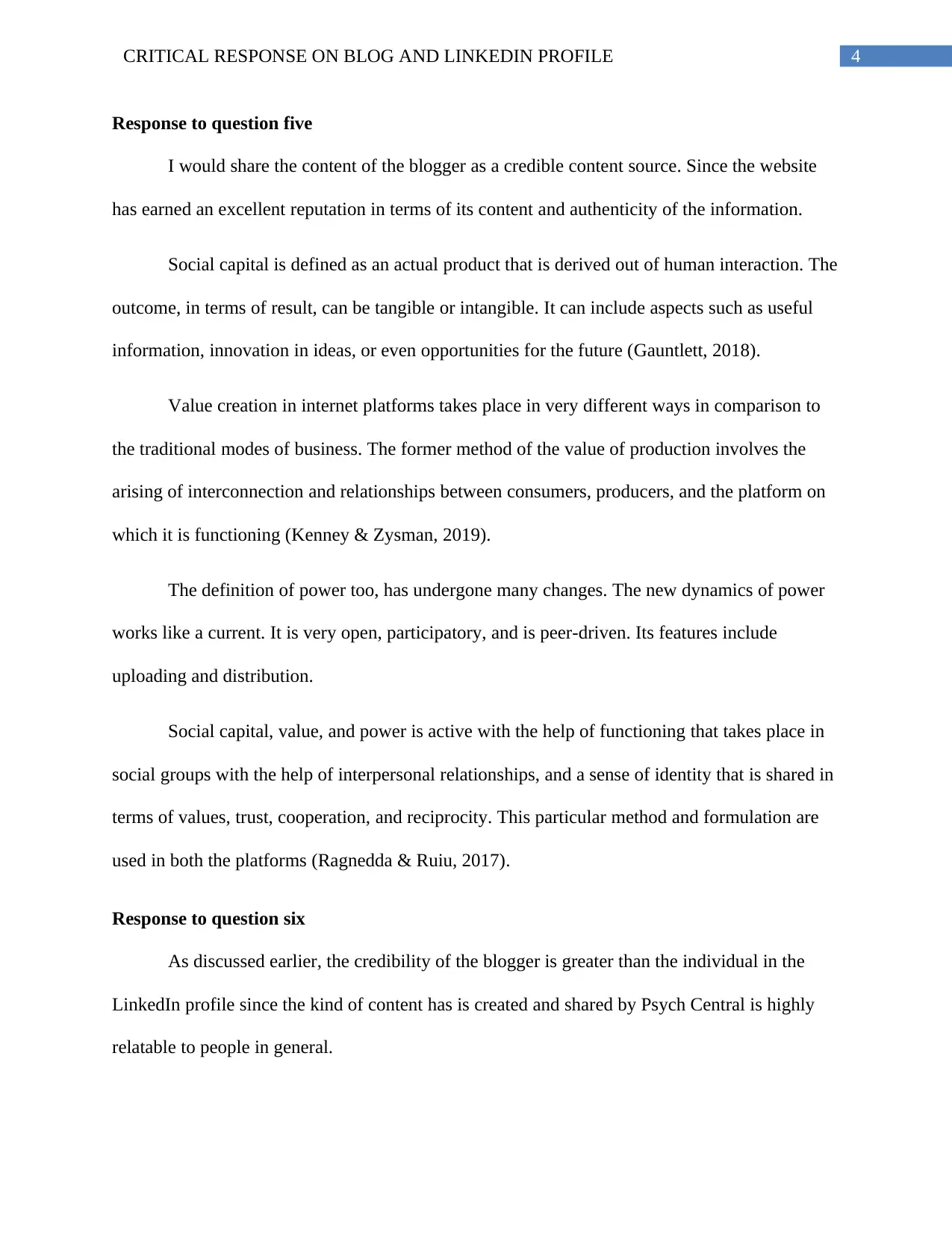
4CRITICAL RESPONSE ON BLOG AND LINKEDIN PROFILE
Response to question five
I would share the content of the blogger as a credible content source. Since the website
has earned an excellent reputation in terms of its content and authenticity of the information.
Social capital is defined as an actual product that is derived out of human interaction. The
outcome, in terms of result, can be tangible or intangible. It can include aspects such as useful
information, innovation in ideas, or even opportunities for the future (Gauntlett, 2018).
Value creation in internet platforms takes place in very different ways in comparison to
the traditional modes of business. The former method of the value of production involves the
arising of interconnection and relationships between consumers, producers, and the platform on
which it is functioning (Kenney & Zysman, 2019).
The definition of power too, has undergone many changes. The new dynamics of power
works like a current. It is very open, participatory, and is peer-driven. Its features include
uploading and distribution.
Social capital, value, and power is active with the help of functioning that takes place in
social groups with the help of interpersonal relationships, and a sense of identity that is shared in
terms of values, trust, cooperation, and reciprocity. This particular method and formulation are
used in both the platforms (Ragnedda & Ruiu, 2017).
Response to question six
As discussed earlier, the credibility of the blogger is greater than the individual in the
LinkedIn profile since the kind of content has is created and shared by Psych Central is highly
relatable to people in general.
Response to question five
I would share the content of the blogger as a credible content source. Since the website
has earned an excellent reputation in terms of its content and authenticity of the information.
Social capital is defined as an actual product that is derived out of human interaction. The
outcome, in terms of result, can be tangible or intangible. It can include aspects such as useful
information, innovation in ideas, or even opportunities for the future (Gauntlett, 2018).
Value creation in internet platforms takes place in very different ways in comparison to
the traditional modes of business. The former method of the value of production involves the
arising of interconnection and relationships between consumers, producers, and the platform on
which it is functioning (Kenney & Zysman, 2019).
The definition of power too, has undergone many changes. The new dynamics of power
works like a current. It is very open, participatory, and is peer-driven. Its features include
uploading and distribution.
Social capital, value, and power is active with the help of functioning that takes place in
social groups with the help of interpersonal relationships, and a sense of identity that is shared in
terms of values, trust, cooperation, and reciprocity. This particular method and formulation are
used in both the platforms (Ragnedda & Ruiu, 2017).
Response to question six
As discussed earlier, the credibility of the blogger is greater than the individual in the
LinkedIn profile since the kind of content has is created and shared by Psych Central is highly
relatable to people in general.
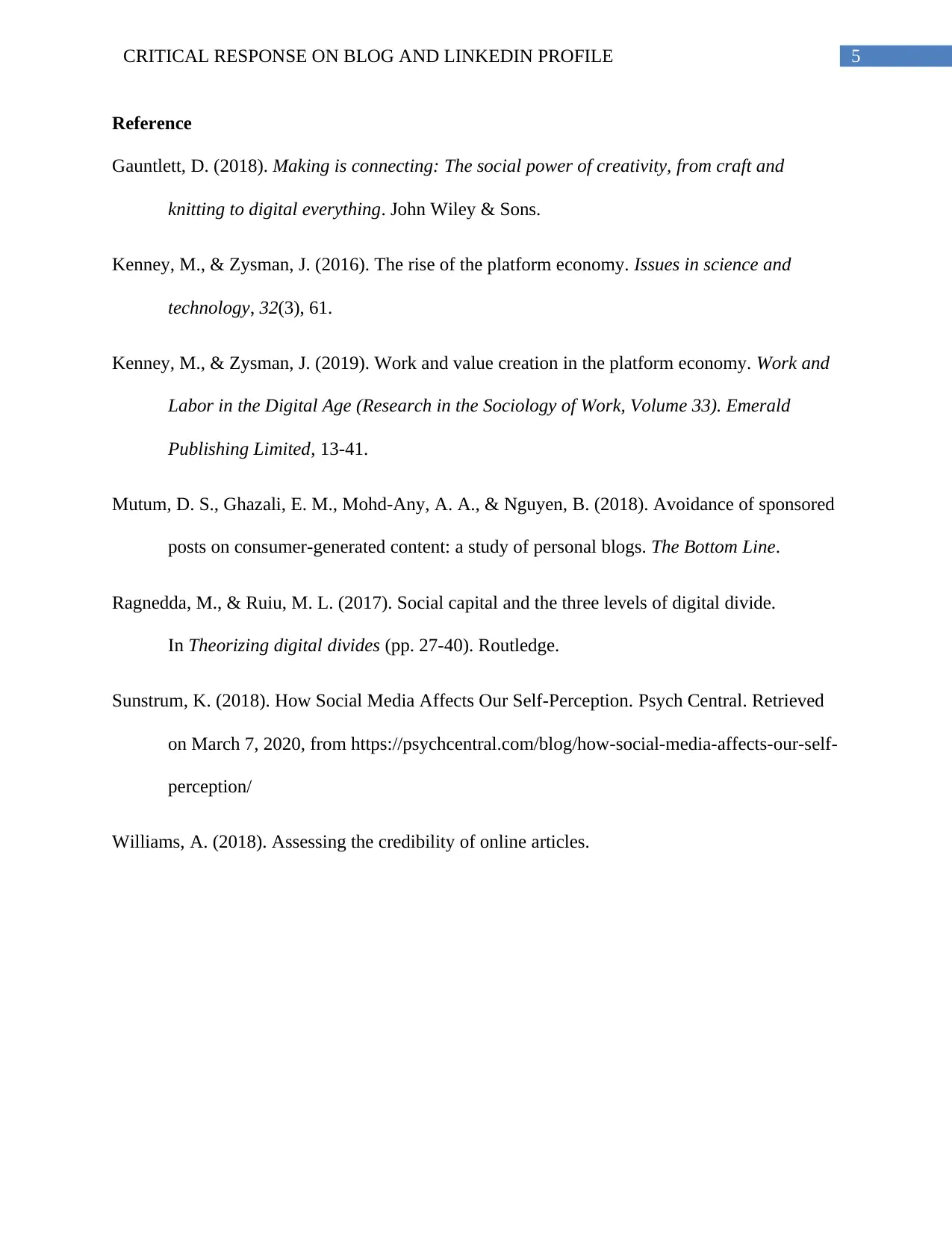
5CRITICAL RESPONSE ON BLOG AND LINKEDIN PROFILE
Reference
Gauntlett, D. (2018). Making is connecting: The social power of creativity, from craft and
knitting to digital everything. John Wiley & Sons.
Kenney, M., & Zysman, J. (2016). The rise of the platform economy. Issues in science and
technology, 32(3), 61.
Kenney, M., & Zysman, J. (2019). Work and value creation in the platform economy. Work and
Labor in the Digital Age (Research in the Sociology of Work, Volume 33). Emerald
Publishing Limited, 13-41.
Mutum, D. S., Ghazali, E. M., Mohd-Any, A. A., & Nguyen, B. (2018). Avoidance of sponsored
posts on consumer-generated content: a study of personal blogs. The Bottom Line.
Ragnedda, M., & Ruiu, M. L. (2017). Social capital and the three levels of digital divide.
In Theorizing digital divides (pp. 27-40). Routledge.
Sunstrum, K. (2018). How Social Media Affects Our Self-Perception. Psych Central. Retrieved
on March 7, 2020, from https://psychcentral.com/blog/how-social-media-affects-our-self-
perception/
Williams, A. (2018). Assessing the credibility of online articles.
Reference
Gauntlett, D. (2018). Making is connecting: The social power of creativity, from craft and
knitting to digital everything. John Wiley & Sons.
Kenney, M., & Zysman, J. (2016). The rise of the platform economy. Issues in science and
technology, 32(3), 61.
Kenney, M., & Zysman, J. (2019). Work and value creation in the platform economy. Work and
Labor in the Digital Age (Research in the Sociology of Work, Volume 33). Emerald
Publishing Limited, 13-41.
Mutum, D. S., Ghazali, E. M., Mohd-Any, A. A., & Nguyen, B. (2018). Avoidance of sponsored
posts on consumer-generated content: a study of personal blogs. The Bottom Line.
Ragnedda, M., & Ruiu, M. L. (2017). Social capital and the three levels of digital divide.
In Theorizing digital divides (pp. 27-40). Routledge.
Sunstrum, K. (2018). How Social Media Affects Our Self-Perception. Psych Central. Retrieved
on March 7, 2020, from https://psychcentral.com/blog/how-social-media-affects-our-self-
perception/
Williams, A. (2018). Assessing the credibility of online articles.
⊘ This is a preview!⊘
Do you want full access?
Subscribe today to unlock all pages.

Trusted by 1+ million students worldwide
1 out of 6
Related Documents
Your All-in-One AI-Powered Toolkit for Academic Success.
+13062052269
info@desklib.com
Available 24*7 on WhatsApp / Email
![[object Object]](/_next/static/media/star-bottom.7253800d.svg)
Unlock your academic potential
Copyright © 2020–2025 A2Z Services. All Rights Reserved. Developed and managed by ZUCOL.





